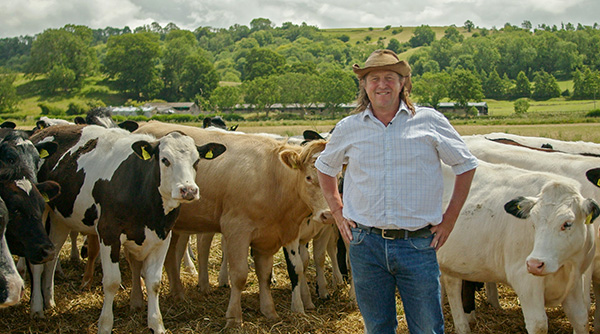

Where: Wiltshire
Size: 650 acres
Type: Predominantly arable
Soil Type: Heavy clay
Mixtures: Herbal Ley & Cover Crops
Bob King has discovered that using cover crops and GS4 herbal leys grazed with livestock is benefiting his arable business, allowing him to cut back on inputs and save money.
Near the Salisbury Plain, the farm has been in Bob’s family since WWII and he now manages it with his father and uncle. It comprises 450 acres of arable, 100 acres of GS4 Herbal Ley and 100 acres of permanent pasture some over clay and some chalk downland.
"We have land in the Higher Level Countryside Stewardship scheme, making use of various options including non grazable AB16 Bumblebird mix, GS4 ley and AB9 wild bird cover. ‘The GS4 mixes have been sown on a rolling basis since 2020 and provide a two year break in the arable cropping rotation. It enables us to reduce our reliance on bought-in fertilisers, by naturally boosting soil fertility”, explains Bob.
So how are the leys managed and terminated?
‘We take a cut of silage in the first year, around late May, and in their second year the leys are primarily grazed. We were conscious of needing to get some livestock into the arable rotation and we run about 300 head of cattle through the year, over a 18 month cycle. We have been grazing the livestock on the herbal leys for 2 years now. Prior to that they were on the permanent pasture. Since we moved onto the herbal leys we’ve seen a lift in growth rates from 0.5kgs to about 0.8-9kgs a day which has enabled us to increase our livestock throughput. I am really pleased with how the cattle perform on the herbal leys and the silage that we make with it.’
The GS4 leys are terminated with glyphosate then direct drilled with an arable crop arable, in fact all the cropping on the farm is now done under a direct drill system.
‘It's been five years since there’s been any major soil movement and the benefits to the soil are clear,’ says Bob.
Bob started using winter cover crops on the farm about 15 years ago as he was concerned about leaving ground bare over winter before going into a maize silage crop. It was when he adopted the direct drilling system that it began to really take off.
‘We grew winter cover crops that we then direct-drilled ‘on the green’ into the cover crop residue and that worked particularly well. Cover crops also give us an opportunity to graze lambs over some arable ground, helping to boost soil fertility further. The more we do this, the more we become convinced it’s what we should be doing. We are now growing more diverse 6-7 species mixes and always looking to include plants that root at different depths to improve soil health.’
Bob is discovering that a conservation agriculture approach is enabling him to cut back on inputs and save money.
‘After a GS4 we have been able to cut out insecticides in the following winter wheat crop because we have beneficial insects in the soil. The legumes in the GS4 are fixing nitrogen so we are also reducing artificial nitrogen inputs too. With the challenges facing farming, including loss of single farm payments and subsidies and rocketing fertiliser prices, this is all very helpful. The Countryside Stewardship scheme is definitely enabling us to make up some of what we are losing from the single farm payments.’
Bob started using Cotswold Grass Seeds fifteen years ago when he first became interested in plant diversity. `There is always someone there at the end of the phone with help, advice and suggestions on seed mixtures.’
Date Posted: 15th March 2023



